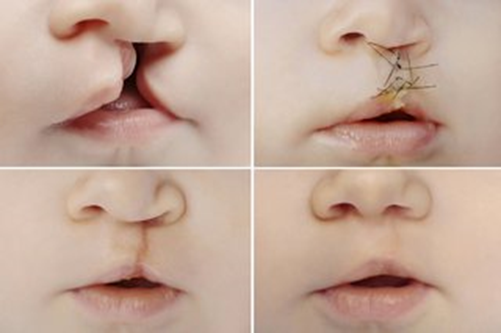A nurse is planning care for a 10-month-old infant who is 8 hours postoperative following cleft palate repair. Which of the following interventions should the nurse include in the infant's plan of care?
Apply and release elbow restraints every hour
Keep the infant supine
Feed the infant with a spoon for 48 hours
Suction the mouth with an oral suction tube
The Correct Answer is A
Choice A reason: Applying and releasing elbow restraints every hour prevents the infant from touching or injuring the surgical site, while allowing some movement and circulation. This is a standard nursing intervention for infants who have undergone cleft palate repair.
Choice B reason: Keeping the infant supine is not recommended, as it increases the risk of aspiration and bleeding. The infant should be placed in a side-lying or upright position to facilitate drainage and prevent pressure on the suture line.
Choice C reason: Feeding the infant with a spoon for 48 hours is not necessary, as it may cause discomfort and trauma to the palate. The infant can be fed with a special nipple or a syringe with a rubber tip that delivers small amounts of formula or breast milk to the side of the mouth.
Choice D reason: Suctioning the mouth with an oral suction tube is contraindicated, as it may damage the palate and cause bleeding or infection. The nurse should use a bulb syringe to gently suction the nose and mouth if needed.

Nursing Test Bank
Naxlex Comprehensive Predictor Exams
Related Questions
Correct Answer is B
Explanation
Choice A reason: Skin integrity is not a reliable indicator of fluid loss, as it can be affected by other factors such as infection, trauma, or allergy. Skin integrity can be assessed by checking for turgor, elasticity, and color.
Choice B reason: Body weight is a reliable indicator of fluid loss, as it reflects the amount of water and electrolytes in the body. Body weight can be measured by using a calibrated scale and comparing it with the previous or baseline weight.
Choice C reason: Blood pressure is not a reliable indicator of fluid loss, as it can be influenced by other factors such as cardiac output, vascular resistance, and stress. Blood pressure can be measured by using a sphygmomanometer and a stethoscope.
Choice D reason: Respiratory rate is not a reliable indicator of fluid loss, as it can be affected by other factors such as oxygen demand, lung function, and airway obstruction. Respiratory rate can be measured by counting the number of breaths per minute.
Correct Answer is ["A","B","E"]
Explanation
Choice A reason: Withholding fluids until the client demonstrates a gag reflex is a preventive measure to avoid aspiration of liquids into the lungs. The gag reflex is a protective mechanism that prevents foreign objects from entering the airway. It can be impaired by anesthesia, surgery, or trauma. Therefore, the nurse should assess the client's gag reflex before offering fluids or food¹.
Choice B reason: Suctioning the nasopharynx as needed is another preventive measure to avoid aspiration of blood or secretions into the lungs. The nurse should monitor the client for signs of bleeding, such as frequent swallowing, restlessness, or bright red drainage. The nurse should also avoid stimulating the throat with tongue blades, straws, or suction catheters, as this can cause bleeding or spasm¹.
Choice C reason: Placing a bedside humidifier at the head of the client's bed is not a preventive measure to avoid aspiration, but rather a comfort measure to soothe the throat and reduce inflammation. Humidified air can help moisten the mucous membranes and promote healing. However, it does not prevent fluids or solids from entering the airway².
Choice D reason: Performing chest physiotherapy is not a preventive measure to avoid aspiration, but rather a treatment measure for clients who have respiratory complications, such as atelectasis or pneumonia. Chest physiotherapy involves percussion, vibration, and postural drainage to mobilize and remove secretions from the lungs. It is not indicated for clients who are postoperative following a tonsillectomy, as it can increase the risk of bleeding or pain³.
Choice E reason: Administering an antiemetic drug if the client is nauseous is a preventive measure to avoid aspiration of vomitus into the lungs. Nausea and vomiting are common postoperative complications that can be caused by anesthesia, pain, or opioids. The nurse should assess the client's nausea level and administer antiemetic drugs as prescribed. The nurse should also position the client on the side or with the head elevated to prevent aspiration¹.
Whether you are a student looking to ace your exams or a practicing nurse seeking to enhance your expertise , our nursing education contents will empower you with the confidence and competence to make a difference in the lives of patients and become a respected leader in the healthcare field.
Visit Naxlex, invest in your future and unlock endless possibilities with our unparalleled nursing education contents today
Report Wrong Answer on the Current Question
Do you disagree with the answer? If yes, what is your expected answer? Explain.
Kindly be descriptive with the issue you are facing.
